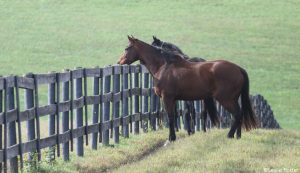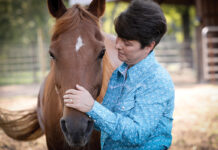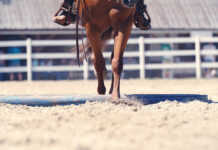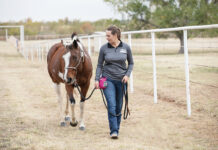 One of the most important facets of horsekeeping is safe fencing. A safe fence prevents a horse from getting loose or tangled up and injuring himself. Since horses tend to be very curious creatures, it’s a safe bet that they will spend some time carefully inspecting and making contact with whatever fence is in place, so it must be specifically designed to safely contain horses. Here are seven common fencing mistakes.
One of the most important facets of horsekeeping is safe fencing. A safe fence prevents a horse from getting loose or tangled up and injuring himself. Since horses tend to be very curious creatures, it’s a safe bet that they will spend some time carefully inspecting and making contact with whatever fence is in place, so it must be specifically designed to safely contain horses. Here are seven common fencing mistakes.
1. Barbed Wire
 |
| Large square wire fence and barbed wire are inappropriate materials for enclosing horse pastures. |
3. Wire strand fence
Wire strand fencing can also slice up a horse that spooks and runs into it. Polymer-coated wire is a much safer choice, and can be electrified as a further means of keeping horses away from it.
4. Uncapped T-posts
Metal T-posts are a wonderful, inexpensive way to set up a perimeter for electric fencing (tape webbing, electric rope, et cetera). But an absolute must for T-posts is the inexpensive T-post cap, a plastic or vinyl sleeve that fits over the post. The jagged metal edge of the plain T-post is razor-sharp, and can slice or even impale a horse that has a run-in with it. It’s always worth a few extra cents per post to cap off these sharp edges.
 |
| T-posts are a secure, inexpensive way to set up fencing, but without caps they have the potential to injure horses. |
5. Electric failure
Electric fence must be checked frequently for adequate charge. Any grass or weeds that grow too tall and touch the fence can weaken the charge, as can fallen tree limbs. A fence tester is a very inexpensive device that will let you know quickly if the fence is still sufficiently charged. Also make sure solar chargers face direct sunlight to operate at full power. If you live in a frequently overcast climate, it’s better to use electricity to charge the fence. Proper grounding rods are also necessary for a good charge; you may need more than one, and they may need to run deep into the ground to create a sufficient electric shock.
6. Rotting posts or boards
Fences rely on the strength of their posts. Pressure-treated wood should be used when installing wooden fence posts, preferably with a diameter of at least four inches. The bottom of the post should be buried two to three feet into the ground for long-lasting support. Wooden posts and boards can both rot over time, so if your fence is older, check these frequently. Broken boards should be fixed immediately to prevent horses from rubbing against exposed nails.
7. Inadequate fence height
The top of any fence should be at least as high as the withers as the tallest horse in the field, while the bottom should be no more than 1 foot off the ground. Three to five boards or electric strands work best.
Many experts recommend against using electric fencing for the perimeter of a farm, since it is a bit flimsier and easier to escape. However, it is ideal for interior fencing, making rotational grazing zones within pastures, and for docile horses that respect it. Many do not recommend electric fencing for foals. Stallions require stouter fencing as well, with more than just electricity holding them in.
One of the safest and sturdiest horse fencing options is tightly woven wire (square, diamond, et cetera). Always use a “sight board” made of vinyl or wood along the top to remind the horse that the fence is there, as wire can be hard to see.
Many fencing options exist that are specifically manufactured to be both safe and strong when used to contain horses, such as PVC rail, flexible board and steel pipe. What you decide to use ultimately depends on your budget and personal tastes.
Further Reading
Pasture Maintenance
Troubleshooting Electric Fences






The size of the wire is very important for smooth wire fencing. I see places selling this smooth wire that is 12 guage. My opinion this is too small for the horses to see. I see some of the coated wire rope at 5/16 inch. This is better but I still feel it is too small. Is there anyone out there that makes at least a 3/8 inch product? I have seen a product with a white ribbon and three high tensile wires spaced inside. That is good, but expensive. Visibility is utmost so with any of the smooth wire products, attaching flags would have to be done. That is why I think the something at least 3/8 inch must be used.